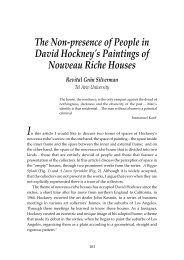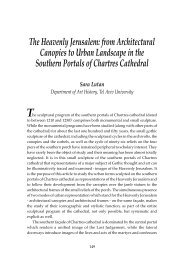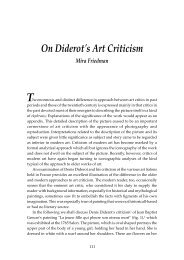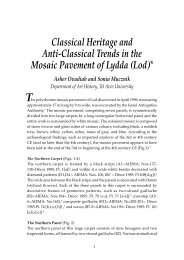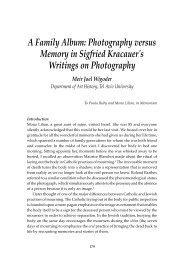The Temple in the Iconography of Early Christian Art Carla Gomez ...
The Temple in the Iconography of Early Christian Art Carla Gomez ...
The Temple in the Iconography of Early Christian Art Carla Gomez ...
You also want an ePaper? Increase the reach of your titles
YUMPU automatically turns print PDFs into web optimized ePapers that Google loves.
as <strong>the</strong> image <strong>of</strong> <strong>the</strong> new church, not<strong>in</strong>g that o<strong>the</strong>r panels <strong>in</strong> Santa Sab<strong>in</strong>a also<br />
demonstrate a parallelism between <strong>the</strong> New Testament and <strong>the</strong> Old. 11<br />
<strong>The</strong> l<strong>in</strong>k to an act <strong>of</strong> acclamatio and a <strong>Christian</strong> emperor has been put forward<br />
by a number <strong>of</strong> scholars. Because <strong>of</strong> <strong>the</strong> cross on <strong>the</strong> ro<strong>of</strong> over <strong>the</strong> pediment,<br />
Lowrie <strong>in</strong>terpreted <strong>the</strong> scene as a <strong>Christian</strong> emperor pray<strong>in</strong>g before a church,<br />
while not<strong>in</strong>g that at <strong>the</strong> time <strong>the</strong> panel was made only palaces were built with<br />
towers, not churches. 12 Delbrueck concluded that <strong>the</strong> figure, perhaps an<br />
emperor, appears <strong>in</strong> an attitude <strong>of</strong> prayer <strong>in</strong> front <strong>of</strong> a small oratory outside <strong>the</strong><br />
city, with <strong>the</strong> towers <strong>in</strong>tended to represent a palace or <strong>the</strong> city gates. He considers<br />
<strong>the</strong> cross makes it impossible to refer <strong>the</strong> scene to <strong>the</strong> Old Testament; nor does<br />
he perceive any connection to <strong>the</strong> New Testament or to non-canonical books. 13<br />
Brehier, on <strong>the</strong> o<strong>the</strong>r hand, believes that <strong>the</strong> person presented by <strong>the</strong> angel<br />
may be <strong>the</strong> Emperor Constant<strong>in</strong>e, and <strong>the</strong> build<strong>in</strong>g beh<strong>in</strong>d him <strong>the</strong> Basilica <strong>of</strong><br />
<strong>the</strong> Holy Sepulchre with <strong>the</strong> entire scene symboliz<strong>in</strong>g <strong>the</strong> <strong>Christian</strong> Empire. 14<br />
Cecchelli returned to <strong>the</strong> <strong>the</strong>sis <strong>of</strong> an acclamatio which <strong>the</strong> presence <strong>of</strong> an angel<br />
and <strong>the</strong> <strong>Temple</strong> connect to <strong>the</strong> bestowal <strong>of</strong> div<strong>in</strong>e authority. He considers that<br />
with<strong>in</strong> such a context, <strong>the</strong> only figure that fits is that <strong>of</strong> K<strong>in</strong>g David, who is an<br />
ancestor <strong>of</strong> Jesus (Mat<strong>the</strong>w 1:1; Luke 1:31; 2:4), which would also expla<strong>in</strong> <strong>the</strong><br />
presence <strong>of</strong> <strong>the</strong> cross on <strong>the</strong> <strong>Temple</strong>. In depict<strong>in</strong>g <strong>the</strong> cross frontally, placed<br />
between two towers <strong>of</strong> <strong>the</strong> façade <strong>of</strong> a Syrian-type church, <strong>the</strong> <strong>in</strong>tention <strong>of</strong> <strong>the</strong><br />
artist seems to have been, accord<strong>in</strong>g to Cecchelli, to emphasize that beh<strong>in</strong>d <strong>the</strong><br />
Jewish <strong>Temple</strong> stands <strong>the</strong> conquer<strong>in</strong>g basilica <strong>of</strong> <strong>the</strong> new <strong>Christian</strong> law. 15<br />
Berthier proposes yet ano<strong>the</strong>r <strong>in</strong>terpretation: <strong>the</strong> scene portrays "<strong>the</strong><br />
found<strong>in</strong>g <strong>of</strong> <strong>the</strong> Church for <strong>the</strong> sake <strong>of</strong> all mank<strong>in</strong>d" and shows Peter's return<br />
to Jerusalem from Joppa after preach<strong>in</strong>g <strong>the</strong> new law to <strong>the</strong> pagans, as narrated<br />
<strong>in</strong> <strong>The</strong> Acts <strong>of</strong> <strong>the</strong> Apostles, 10 and 11. He is stand<strong>in</strong>g aga<strong>in</strong>st <strong>the</strong> background<br />
<strong>of</strong> <strong>the</strong> <strong>Christian</strong> Church and its cross, and <strong>the</strong> build<strong>in</strong>g depicted is a fifth century<br />
church. 16<br />
Leclercq holds that <strong>the</strong> scene represents Jerusalem <strong>in</strong> <strong>the</strong> form <strong>of</strong> <strong>the</strong> façade<br />
<strong>of</strong> a church with two towers. 17 Kantorowicz's article concludes that <strong>the</strong> scene is<br />
a literal depiction <strong>of</strong> <strong>the</strong> Prophet Malachi's prophesy <strong>of</strong> <strong>the</strong> com<strong>in</strong>g <strong>of</strong> <strong>the</strong><br />
Messiah (Malachi 3:1-2) - "an eschatological Advent" <strong>in</strong> front <strong>of</strong> <strong>the</strong> <strong>Temple</strong>.<br />
Malachi, <strong>the</strong> last <strong>of</strong> <strong>the</strong> prophets, constitutes <strong>the</strong> l<strong>in</strong>k between <strong>the</strong> Old and <strong>the</strong><br />
New Testaments. <strong>The</strong> scene describes <strong>the</strong> revelation <strong>of</strong> <strong>the</strong> Pantocrator <strong>in</strong> front<br />
<strong>of</strong> <strong>the</strong> <strong>Temple</strong>, with <strong>the</strong> cross over his head predict<strong>in</strong>g <strong>the</strong> com<strong>in</strong>g <strong>of</strong> <strong>the</strong> New<br />
Testament and perhaps <strong>the</strong> Second Com<strong>in</strong>g itself. 18<br />
<strong>The</strong> form <strong>of</strong> <strong>the</strong> build<strong>in</strong>g and <strong>the</strong> figures which appear and are <strong>in</strong> accordance<br />
with <strong>the</strong> Gospel story, suggest that <strong>of</strong> all <strong>the</strong> proposed <strong>in</strong>terpretations, <strong>the</strong> one<br />
that considers that it is Zacharias <strong>the</strong> High Priest before <strong>the</strong> <strong>Temple</strong> is <strong>the</strong> most<br />
64


